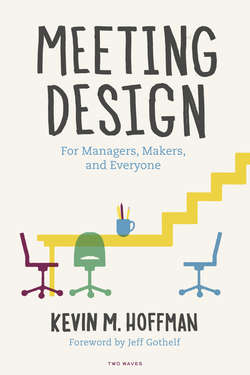Читать книгу Meeting Design - Kevin M. Hoffman - Страница 25
На сайте Литреса книга снята с продажи.
Visual Listening
ОглавлениеVisualization is a surprisingly effective method of getting memories into your brain (see Figure 2.6). In his book Moonwalking with Einstein, Joshua Foer summarizes studies that demonstrate when shown an image, your brain has a nearly infallible ability to know whether or not it’s been seen previously.8 This fact applies to a small set of images or thousands of images, and it works over extended periods of time. But keep in mind (pun intended) that memory is still unreliable and can be exhausted—this is the design constraint all meetings face. Creating and reinforcing memories with visuals can manage and even reduce this constraint.
FIGURE 2.6 Visualization as an input mechanism can be used far more effectively in most meetings.
Whiteboarding an idea (visualizing it publicly) allows a group to point at the same thing and say “yes,” or “no.”
—DANA CHISNELL CODIRECTOR, CENTER FOR CIVIC DESIGN
Someone who takes notes in meetings can be called a scribe or a meeting secretary. They transcribe the discussion at a nearly impossible level of detail, and if you’re lucky they make those notes available to attendees. In most organizations, the notes are rarely revisited. You leave a meeting focused on the tasks that apply exclusively to you. Once you feel like you’ve got those tasks down, you aren’t likely to reread meeting notes. Those notes disappear in the piles of email messages that are there to make you feel better, but don’t really add to the quality of our work.
Stop taking notes in meetings this way, now and forever.
Give the scribe a different job: get those notes in front of everyone’s eyes at the same time, in real time while the discussion is happening. While people are engaged in talking (or for our purposes, “auditory input and output”), the scribe creates a visual record of only the main ideas, the conflicts, and the decisions on the wall. It needs to be large enough so that anyone in the room can read it from wherever they are sitting. That way, when the scribe captures something incorrectly, someone in the meeting can speak up and provide a correction.
Attendees in this scenario see the conversation unfold visually before them. It creates a feedback loop verifying accuracy between what people hear and see. They don’t have to engage in both all the time, but switching between listening and looking modes becomes possible when it suits the individual. Miss something? Look at the wall, or the screen if you are meeting with a distributed group. Suddenly, meeting notes accommodate multiple input modes, as well as create a central point of focus.
For example, Jane’s meeting was missing visualized discussion. She relied exclusively on listening to get the same action item into everyone’s mind. A public note taker could have visualized those lists in real time by pulling the parts of the conversation out that fit into each list. Leaving the meeting with that visual would have clearly aligned all three teams on what each list was for, and where different savings they anticipated should go. Jane’s teams would have provided documentation that reduced Jane’s extra effort, as opposed to increasing it, because the structure of the list would have been more clearly defined in their memories.
The practice of visual facilitation is a little beyond just note taking. It involves using simple visuals and sketches to represent ideas. It’s practiced by accomplished facilitators worldwide, and there are regular conferences dedicated to its practice. Compared to words, a diagram or sketch conveys more information without much additional effort. Concepts of time, connection, disconnection, emotion, and more can be represented more quickly with lines, boxes, arrows, and simple facial drawings. For more on visual approaches facilitation, make sure that you read Chapter 5, “Facilitation Strategy and Style.”
